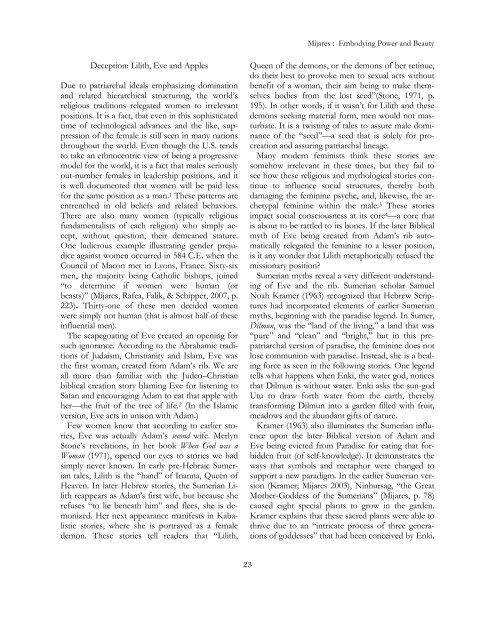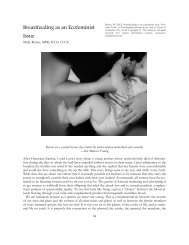RE:IJSNC, Issue 1, Volume 2, May 2012 - Ocean Seminary College
RE:IJSNC, Issue 1, Volume 2, May 2012 - Ocean Seminary College
RE:IJSNC, Issue 1, Volume 2, May 2012 - Ocean Seminary College
Create successful ePaper yourself
Turn your PDF publications into a flip-book with our unique Google optimized e-Paper software.
Deception: Lilith, Eve and Apples<br />
Due to patriarchal ideals emphasizing domination<br />
and related hierarchical structuring, the world’s<br />
religious traditions relegated women to irrelevant<br />
positions. It is a fact, that even in this sophisticated<br />
time of technological advances and the like, suppression<br />
of the female is still seen in many nations<br />
throughout the world. Even though the U.S. tends<br />
to take an ethnocentric view of being a progressive<br />
model for the world, it is a fact that males seriously<br />
out-number females in leadership positions, and it<br />
is well documented that women will be paid less<br />
for the same position as a man. 1 These patterns are<br />
entrenched in old beliefs and related behaviors.<br />
There are also many women (typically religious<br />
fundamentalists of each religion) who simply accept,<br />
without question, their demeaned stature.<br />
One ludicrous example illustrating gender prejudice<br />
against women occurred in 584 C.E. when the<br />
Council of Macon met in Lyons, France. Sixty-six<br />
men, the majority being Catholic bishops, joined<br />
“to determine if women were human (or<br />
beasts)” (Mijares, Rafea, Falik, & Schipper, 2007, p.<br />
223). Thirty-one of these men decided women<br />
were simply not human (that is almost half of these<br />
influential men).<br />
The scapegoating of Eve created an opening for<br />
such ignorance. According to the Abrahamic traditions<br />
of Judaism, Christianity and Islam, Eve was<br />
the first woman, created from Adam’s rib. We are<br />
all more than familiar with the Judeo–Christian<br />
biblical creation story blaming Eve for listening to<br />
Satan and encouraging Adam to eat that apple with<br />
her—the fruit of the tree of life. 2 (In the Islamic<br />
version, Eve acts in unison with Adam.)<br />
Few women know that according to earlier stories,<br />
Eve was actually Adam’s second wife. Merlyn<br />
Stone’s revelations, in her book When God was a<br />
Woman (1971), opened our eyes to stories we had<br />
simply never known. In early pre-Hebraic Sumerian<br />
tales, Lilith is the “hand” of Inanna, Queen of<br />
Heaven. In later Hebrew stories, the Sumerian Lilith<br />
reappears as Adam’s first wife, but because she<br />
refuses “to lie beneath him” and flees, she is demonized.<br />
Her next appearance manifests in Kabalistic<br />
stories, where she is portrayed as a female<br />
demon. These stories tell readers that “Lilith,<br />
23<br />
Mijares : Embodying Power and Beauty<br />
Queen of the demons, or the demons of her retinue,<br />
do their best to provoke men to sexual acts without<br />
benefit of a woman, their aim being to make themselves<br />
bodies from the lost seed”(Stone, 1971, p.<br />
195). In other words, if it wasn’t for Lilith and these<br />
demons seeking material form, men would not masturbate.<br />
It is a twisting of tales to assure male dominance<br />
of the “seed”—a seed that is solely for procreation<br />
and assuring patriarchal lineage.<br />
Many modern feminists think these stories are<br />
somehow irrelevant in these times, but they fail to<br />
see how these religious and mythological stories continue<br />
to influence social structures, thereby both<br />
damaging the feminine psyche, and, likewise, the archetypal<br />
feminine within the male. 3 These stories<br />
impact social consciousness at its core 4—a core that<br />
is about to be rattled to its bones. If the later Biblical<br />
myth of Eve being created from Adam’s rib automatically<br />
relegated the feminine to a lesser position,<br />
is it any wonder that Lilith metaphorically refused the<br />
missionary position?<br />
Sumerian myths reveal a very different understanding<br />
of Eve and the rib. Sumerian scholar Samuel<br />
Noah Kramer (1963) recognized that Hebrew Scriptures<br />
had incorporated elements of earlier Sumerian<br />
myths, beginning with the paradise legend. In Sumer,<br />
Dilmun, was the “land of the living,” a land that was<br />
“pure” and “clean” and “bright,” but in this prepatriarchal<br />
version of paradise, the feminine does not<br />
lose communion with paradise. Instead, she is a healing<br />
force as seen in the following stories. One legend<br />
tells what happens when Enki, the water god, notices<br />
that Dilmun is without water. Enki asks the sun-god<br />
Utu to draw forth water from the earth, thereby<br />
transforming Dilmun into a garden filled with fruit,<br />
meadows and the abundant gifts of nature.<br />
Kramer (1963) also illuminates the Sumerian influence<br />
upon the later Biblical version of Adam and<br />
Eve being evicted from Paradise for eating that forbidden<br />
fruit (of self-knowledge). It demonstrates the<br />
ways that symbols and metaphor were changed to<br />
support a new paradigm. In the earlier Sumerian version<br />
(Kramer; Mijares 2003), Ninhursag, “the Great<br />
Mother-Goddess of the Sumerians” (Mijares, p. 78)<br />
caused eight special plants to grow in the garden.<br />
Kramer explains that these sacred plants were able to<br />
thrive due to an “intricate process of three generations<br />
of goddesses” that had been conceived by Enki.



